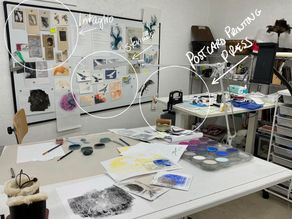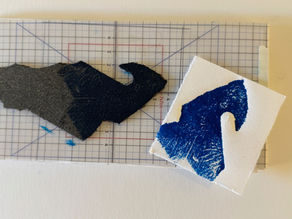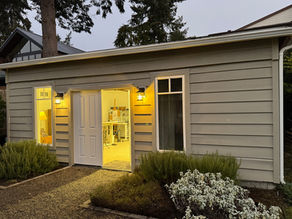The Postcard Is not The point, Part 2
- Caroline Clarke

- Jun 9
- 5 min read

This project—traveling with a tiny printing press, a sketchbook, and a set of postcards—was never about keeping up.
Well, not exactly.
Yes, it was about being present, and noticing what felt like a postcard waiting to happen. But it quickly evolved into recognizing that some images could wait—that they’d stay with me, gradually turning into ideas I could act on. This post is about one of those: castles and jackdaws.
It’s also about practical things. What, in retrospect, could I have done to better support that creative process while traveling?
And this is where we start.
Next Time, I’ll Begin with the Drawing

Back in Liverpool, we stopped at the Walker Art Gallery. That’s where I found the Metamorphosis Case I mentioned earlier, with sculptures by Johnny Vegas and Emma Rodgers. Stunning. One of those moments when you round a corner and there it is — the thing that instantly excites.

For me, it was Emma Rodgers’ sculpture of Icarus. The material choices echoed the subject of transformation in process. I later read that sketching is central to her creative research and interpretation.
I stood in front of the Metamorphosis Case. What if I were to draw it?
I’d use black ink on white paper. Nothing tidy. A dip pen, a pipette from the ink bottle, or a stick. Something smudgy and hard-edged. And just as I’m thinking this, I notice a drawing in the case — also smudgy. Johnny Vegas had the same idea.
I meant to draw Icarus that day in my sketchbook. I didn’t. I was looking for things that might fit on a postcard, and I’d jotted down that I'd try a light-field monotype painted on the plate with a stick and ink. But I never did.
What if I’d spent 20 minutes sketching that night, instead of only writing it down? Instant delight, surely. And maybe a spark of an idea worth following.

A few days later, still in Liverpool, another jolt: the Stations of the Cross at the Catholic Cathedral. Bronze reliefs by Sean Rice, completed in 1992. Raw and beautiful.
I took a picture of one of his other sculptures though. It reminded me of a moment when my younger self was drawn to religious art inspired by Vatican II and liberation theology.
I later read that Rice also painted in watercolors and oil. Not to my liking. But his charcoal drawings —studies for his sculptures — oh my, yes. They were gestural, with varied marks and textures. It's interesting to contemplate how he translated those drawings into his bronze reliefs.
If I’d drawn in my sketchbook, capturing my feelings as I looked at Rice’s bronze reliefs, I’d be doing the reverse. I wish I had. What would have surfaced in the marks and shapes? Where would I take it?
Note to self: Next time, don’t wait. Draw these jolts. Begin with the drawing — and only then, journal. Not for anyone else, just me.
Working Small
A jackdaw landed on the edge of Alnwick Castle’s parapet. Then another. They came and went. No other birds — just jackdaws. I took notes and pictures, of course, but at the time, I wasn’t sure what I'd do with them.
They're \everywhere in the UK: in the fields of Anglesey, on the rooftops of Grange-over-Sands. They absolutely own the castles in Northumberland.
A smaller member of the crow family, jackdaws are social, monogamous, and nest in chimneys, towers, and ruins. Their pale eyes take some getting used to. I liked them immediately.
I pulled out my copy of The Once and Future King. I remembered castles, but were there jackdaws? Sure enough:
“The jackdaws were chattering in the turrets, and the rooks were cawing in the elms.”
Not principal characters in the story, but part of that world. I felt a sudden kinship with young Wart.
We visited four castles in all: Beaumaris, Conwy, Alnwick, and Bamburgh. I couldn’t get enough. I photographed stone textures, iron hinges, carved lintels. In my sketchbook, I mapped Beaumaris with its moat, and Alnwick's tooth-like battlements dark against the sky.
I knew this would be a postcard.
Back in the studio, I sketched several silhouettes of Alnwick and chose one that included both round and square towers.

I flipped my sketch for the reference and rolled out sepia ink on the plate for a dark-field monotype. I carved out the silhouette with Q-Tips and sculpting tools, laid gauze across the ink for texture, something close to the feel of the walls themselves, and pulled three prints. One ghost print onto a dampened postcard, for a softer tone.

I looked up “jackdaws in flight” and noted those fingered wingtips, the tilt and shape of the blur. With tracing paper, I tested placement. I painted three birds, really just smudges, one above the central tower, two in the distance. The final layer of the postcard came together with the help of diluted sepia ink, a dark umber colored pencil, and a white gel pen (for the wing tips). Texture held and values unified.
The process wasn’t fast or loose. (I have yet to figure out how to be gestural on a 4 x 6-inch plate.) I wanted motion against stillness, texture, balance. And got that.
But the finished card was such a little, tiny artifact. After all that time spent traveling and then in the studio... was it really worth it?
Working so small — that’s the part I don’t know. The image felt so constructed. And tellingly, shortly after finishing the postcard, I went straight to our local life drawing session, and pulled out a big sheet of paper. So big that I had to swing my whole arm to draw.
What a relief.
Looking back, though, I loved every minute with those castles — and drawing them in my sketchbook.
Same with the jackdaws. Never just birds in the background. Like the first postcard, before the trip: a crow flying away from my house. Come on, let’s go.

And now this one: they're circling above the castle wall. Why?
Some images stay with you — that’s the point.
What’s Next
In the final post, I’ll take a step back to see what I figured out about traveling as an artist.
This whole project has been an experiment. So is the way I’m reflecting on it.
More on that next time.
Afterword
Impressions from Northumberland




























Comments